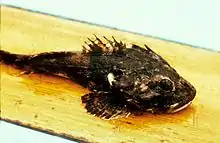Myoxocephalus polyacanthocephalus
Myoxocephalus polyacanthocephalus, the great sculpin, s a species of marine ray-finned fish belonging to the family Cottidae, the typical sculpins. It is found in the North Pacific Ocean from the Bering Sea and the Aleutian Islands, and extends from Hokkaido and the Kamchatka Peninsula to the Puget Sound, Washington.[1][2][3] It is the largest member of the genus Myoxocephalus and the second most common in the Bering Sea.[4] It can grow to a size of 80 cm and 9 kg weight.[2]
| Myoxocephalus polyacanthocephalus | |
|---|---|
 | |
| Scientific classification | |
| Domain: | Eukaryota |
| Kingdom: | Animalia |
| Phylum: | Chordata |
| Class: | Actinopterygii |
| Order: | Scorpaeniformes |
| Family: | Cottidae |
| Genus: | Myoxocephalus |
| Species: | M. polyacanthocephalus |
| Binomial name | |
| Myoxocephalus polyacanthocephalus (Pallas, 1814) | |
| Synonyms | |
Myoxocephalus polyacanthocephalus is a predatory fish.[5] It has acellular bones.[6]
References
- Froese, Rainer; Pauly, Daniel (eds.) (2014). "Myoxocephalus polyacanthocephalus" in FishBase. April 2014 version.
- "Bottomfish Identification Guide: Great Sculpin Myoxocephalus polyacanthocephalus". Washington Department of Fish & Wildlife. Archived from the original on May 12, 2014. Retrieved May 9, 2014.
- "Myoxocephalus polyacanthocephalus (Pallas, 1814)". GBIF.org. Retrieved May 9, 2014.
- TenBrink, Todd T. (2009). "Chapter 3: Age, growth, reproduction, and mortality of the great Sculpin, Myoxocephalus polyacanthocephalus, in the Eastern Bering Sea". NORTH PACIFIC RESEARCH BOARD FINAL REPORT (Report). National Marine Fisheries Service (NOAA). pp. 54–81.
- Tokranov, A. M.; Orlov, A. M. (December 2013). "Feeding pattern of the great sculpin Myoxocephalus polyacanthocephalus (Cottidae) and its position in the trophic system of near-Kamchatka waters". Journal of Ichthyology. 53 (11): 969–981. doi:10.1134/s0032945213110088. S2CID 6556127.
- Horton JM, Summers AP (May 2009). "The material properties of acellular bone in a teleost fish". Journal of Experimental Biology. 212 (9): 1413–1420. doi:10.1242/jeb.020636. PMID 19376962.
This article is issued from Wikipedia. The text is licensed under Creative Commons - Attribution - Sharealike. Additional terms may apply for the media files.